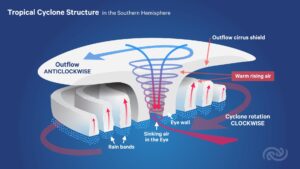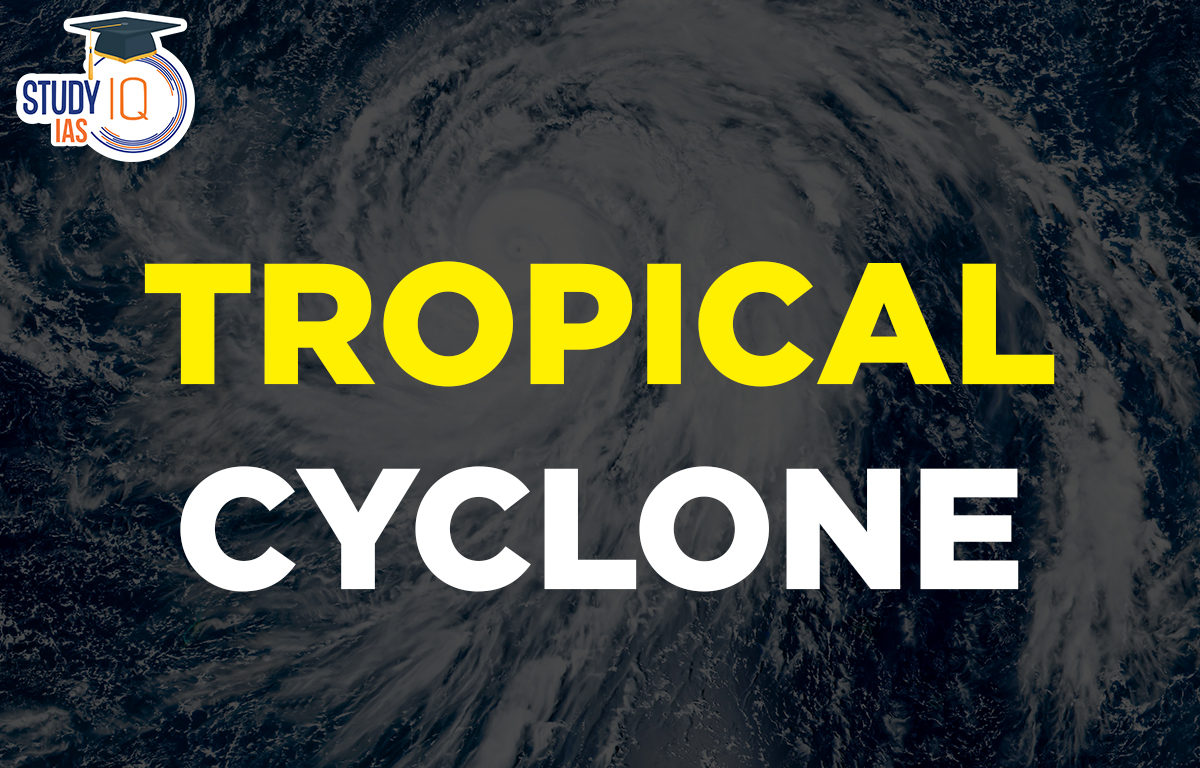Table of Contents
Tropical Cyclone
A tropical cyclone is an organised circulation, warm-core low-pressure system that forms over tropical or subtropical waters without any connected “front” and has a tropical or subtropical origin. A tropical cyclone cannot form unless some favourable environmental conditions exist.
Also Read: Cyclone Biparjoy
What is a Cyclone?
Cyclones are areas of low pressure that have rapid inward air circulation. In the Northern Hemisphere, air circulates anticlockwise, while in the Southern Hemisphere, air circulates clockwise. Cyclones are frequently accompanied by violent storms and inclement weather.
Cyclone is derived from the Greek word Cyclos, which means snake coils. Henry Peddington coined the term because tropical storms in the Bay of Bengal and the Arabian Sea resemble coiled serpents of the sea.
Types of Cyclones
Cyclones are majorly classified into two types namely Tropical Cyclone and Temperate Cyclone.
Tropical cyclones are violent storms that form over tropical oceans and move to coastal areas, causing widespread destruction due to high winds, heavy rainfall, and storm surges. Tropical cyclones are one of the world’s most destructive natural disasters. Tropical cyclones form and strengthen over warm tropical oceans.
Tropical Cyclone Diagram
Here are the Tropical Cyclone Diagram given below:

Tropical Cyclone Formation
There are some necessary conditions that favour the formation and intensification of tropical storms are:
- A large area of the sea surface with a temperature greater than 27° C.
- Presence of Coriolis force.
- Variations in vertical wind speed are minor.
- A weak low-pressure area or low-level cyclonic circulation that existed previously.
- The system of upper divergence above sea level.
Stages of Formation of Tropical Cyclone
The development cycle of tropical cyclones may be divided into three stages:
Formation and Initial Development Stage
The formation and early development of a cyclonic storm are dependent on the transfer of water vapour and heat from the warm ocean to the overlying air, which occurs primarily through evaporation from the sea surface. Convection with condensation of rising air above the ocean surface promotes the formation of massive vertical cumulus clouds.
Stage of Maturity
When a tropical storm intensifies, the air rises and tends to spread out horizontally at the tropopause level. When air spreads out, a high level of positive pressure is produced, which accelerates the downward motion of air due to convection.
Subsidence causes air to warm up by compression, resulting in a warm ‘Eye’ (low-pressure centre). A mature tropical cyclone in the Indian Ocean is distinguished by a concentric pattern of highly turbulent giant cumulus thundercloud bands.
Mature Stage
As soon as its source of warm moist air begins to ebb or is abruptly cut off, a tropical cyclone begins to weaken in terms of central low pressure, internal warmth, and extremely high speeds. This occurs after it makes landfall or passes over cold water.
Cyclones in India
Tropical cyclones form over the Indian Ocean, the Arabian Sea, and the Bay of Bengal. These tropical cyclones wreaked havoc on the Indian coastal states of Tamil Nadu, Andhra Pradesh, West Bengal, Odisha, and Gujarat, with extremely high wind speeds and heavy rainfall (These five states are more vulnerable to cyclone disasters than others in India). Most of these cyclones are extremely destructive due to their high wind speeds and torrential rain.
Characteristics of Tropical Cyclones
A tropical cyclone is a rapidly rotating storm that forms over tropical oceans and draws energy from there. It has a low-pressure centre and clouds spiralling towards the eye-wall, which surrounds the “eye,” the central part of the system where the weather is normally calm and cloud-free. It has a diameter of 200 to 500 km but can reach 1000 km. A tropical cyclone brings strong winds, heavy rain, high waves, and, in some cases, devastating storm surges and coastal flooding. In the Northern Hemisphere, winds blow counterclockwise, while in the Southern Hemisphere, winds blow clockwise. Tropical cyclones of certain strength are given names for public safety reasons.
Causes of Tropical Cyclones
Cyclones are associated with three elements that cause destruction during their occurrence. These are as follows:
- Even in their early stages, tropical cyclones pose one of the greatest threats to life and property. They include a variety of hazards, each of which can have a significant impact on life and property, such as storm surges, flooding, extreme winds, tornadoes, and lighting. These hazards interact with one another, significantly increasing the possibility of a loss of life and material damage.
- Strong Winds/Squalls cause damage to installations, homes, communications systems, trees, and other structures, resulting in loss of life and property.
- Heavy Rains and Inland Flooding: Rain is a major issue for those who have lost shelter as a result of the cyclone. Heavy rainfall is typically dispersed over a large area, causing large-scale soil erosion and embankment weakening.
- Storm Surge: It is a sudden rise in sea level near the coast caused by a powerful tropical cyclone. Storm surge causes seawater to inundate low-lying coastal areas, drowning people and livestock, eroding beaches and embankments, destroying vegetation, and reducing soil fertility.
Management of Cyclones
There are numerous structural and non-structural measures available for effective cyclone disaster management. Construction of cyclone shelters, construction of cyclone-resistant buildings, road links, culverts, bridges, canals, drains, saline embankments, surface water tanks, communication and power transmission networks, and so on are among the structural measures.
Non-structural measures include early warning dissemination systems, coastal zone management, disaster risk management, and capacity building for all stakeholders. These measures are being implemented and addressed on a state-by-state basis through the World Bank-funded National Cyclone Risk Mitigation Project (NCRMP).
Tropical Cyclones FAQs
Q. Who is the father of the cyclone?
Ans. Captain Harry Piddington of Calcutta published 40 papers on tropical storms in the Journal of the Asiatic Society between 1835 and 1855, coining the term “cyclone,” which means “snake coil.” He published his monumental work on the “Laws of the Storms” in 1842.
Q. What happens after a cyclone?
Ans. Following a cyclone, basic services such as power, sewage, and freshwater supply may be disrupted, increasing personal risk. One of the most serious risks is polluted water. Take the precaution of boiling water before drinking until your local council declares it safe.
Q. What is the primary function of a cyclone?
Ans. In general, cyclones are used to collect particles larger than 10 micrometres in diameter and are sometimes referred to as “pre-cleaners” because they are frequently used to reduce particulate matter inlet loading to downstream collection devices by removing larger abrasive particles.
Q. How can we safeguard against cyclones?
Ans. Remove dead branches or dying trees near the house; anchor removable objects that can fly in strong winds, such as lumber piles, loose tin sheets, loose bricks, garbage cans, signboards, and so on. Keep some wooden boards on hand in case glass windows need to be boarded.
Q. Why do cyclones end on land?
Ans. When a tropical cyclone makes landfall, the eye typically closes in on itself due to negative environmental factors such as friction with the terrain, which reduces surf, and drier continental air.
Q. What power do tropical cyclones possess?
Ans. Water vapour (water in its gaseous state) cools as it rises. As a result of this cooling, the water vapour condenses into a liquid that we see as clouds.
Q. Who names cyclones in India?
Ans. Cyclones developing over the north Indian Ocean, including the Bay of Bengal and the Arabian Sea, are named by the India Meteorological Department (IMD). It also issues advisories on the development of cyclones and storms to 12 other nations in the region.
Other Indian Geography Topics
Other Fundamental Geography Topics


 Story of Meera Bai and Her Devotion For ...
Story of Meera Bai and Her Devotion For ...
 Desert Climate, Distribution, Climatic C...
Desert Climate, Distribution, Climatic C...
 Deserts of India Map, Features of Thar D...
Deserts of India Map, Features of Thar D...





















